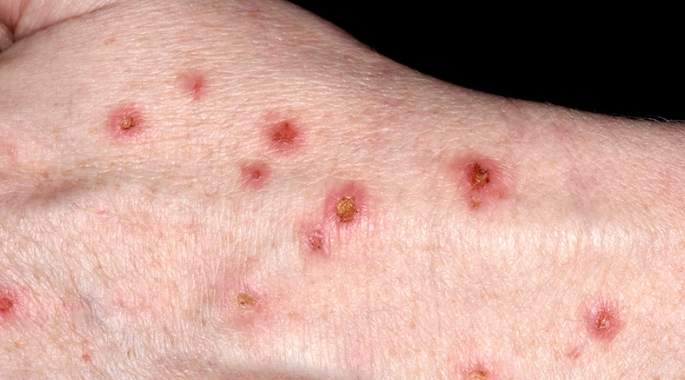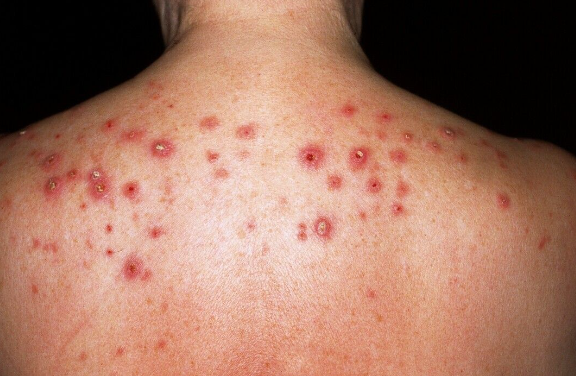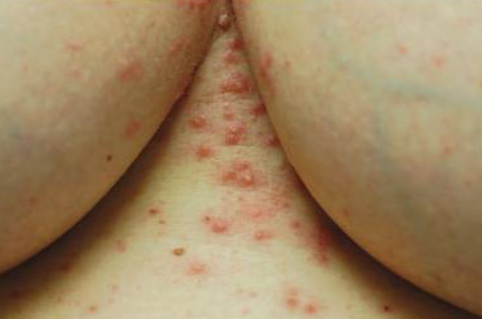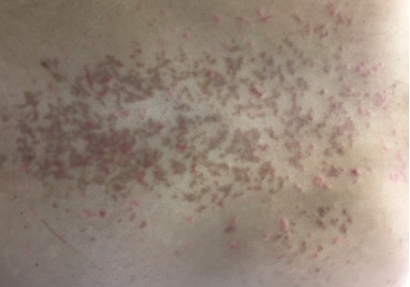Prurigo is a chronic, recurrent and polyetiologic disease belonging to the group of neuroallergic dermatoses. Primary morphological elements are papules, urticarial papules, hemispherical papular lesions and nodules accompanied by intense pruritus. ICD-10 Code: L28.
Etiology of prurigo is unknown. Prurigo may be a manifestation of a nonspecific reaction developed against the background of blood diseases (lymphogranulomatosis, lymphocytosis), paraneoplastic processes, systemic diseases, pregnancy, photosensitization, stress, insect bites.
Classification:- L28.1 Nodular prurigo
- L28.2 Other prurigo
- Prurigo Simplex
- Prurigo pigmentosa
- Prurigo chronica multiformis
- L57.8Solar prurigo
- O26.9 Prurigo of pregnancy
Prurigo simplex
Prurigo simplex, also known as or chronic urticarial papules, can occur in both adults and, less commonly, in children. It can manifest in two forms: acute and chronic.
Acute form of the disease is characterized by the appearance of dense, lentiform, noncoalescing, reddish-brown papules on the extensor surfaces of the upper and lower limbs and occasionally on the trunk. These papules may develop an urticarial character (edematous papules) due to swelling and intense pruritus. As a result of scratching, their surface becomes covered with hemorrhagic crusts, and their separation may leave temporary pigmentation or whitish scars. Minor general health problems may precede the rash for 1-2 days. The acute form of the disease may last from 2 weeks to 4 months. Patients often experience neurotic disorders due to severe itching, such as irritability and insomnia.
Chronic form of the disease is characterized by a prolonged, recurrent course and the presence of papular eruptions in addition to areas of lichenification. Individuals with increased sensitivity to ultraviolet rays often experience seasonal exacerbations (spring or summer forms of prurigo) characterized by eruptions on exposed areas of the skin.
Nodular prurigo
Nodular prurigo, also known as prurigo nodularis, is currently classified into two forms: early (atopic) and late (non-atopic).
Early form occurs in children and adolescents with atopic dermatitis and is sometimes referred to as atopic prurigo. It is associated with skin hypersensitivity to various environmental allergens. The late form affects mainly women over 40 years of age.
Clinical presentation of both forms is characterized by the presence of monomorphic eruptions consisting of isolated, large (0.5 to 1 cm or more in diameter), firm papules and nodules that protrude significantly above the skin surface. These lesions are initially the color of normal skin, but may later become reddish-brown. The surface of the lesions is smooth, and scaly, hyperkeratotic, or verrucous areas may appear on the surface over time. Due to intense paroxysmal itching, excoriations covered with hemorrhagic crusts may develop on these papules and nodules. Resolution of the pathologic elements often occurs by ulceration and scarring. The eruptions are symmetrically localized on the extensor surfaces of the upper and lower limbs, less often on the flexor surfaces and the back.
Disease is accompanied by intense, paroxysmal pruritus, which worsens after the appearance of the eruptions. This is due to hyperplasia of nerve fibers in the affected areas of the skin. The disease can last for years and is associated with brief remissions.
Prurigo of Pregnancy
Also known as atopic eruption of pregnancy, prurigo gestationis, or Spangler's papular dermatitis of pregnancy, this is a common specific skin disorder of pregnancy characterized by pruritic eczematous or papular eruptions. Unlike other dermatoses of pregnancy, it usually presents before the third trimester. Two-thirds of cases are characterized by eczematous changes on the skin in typical atopic areas such as the neck and flexures. These eruptions usually respond to treatment and resolve spontaneously after delivery, but may recur in subsequent pregnancies. The fetus is not affected, but there is an increased risk of atopic dermatitis in children.
Prurigo pigmentosa
Etiology and pathogenesis of prurigo pigmentosa are not well understood. While the etiology is unknown, several mechanical, hormonal, and metabolic triggers have been identified, including ketogenic diet. Improvement with antibiotic treatment suggests a role for bacterial infection.
It mainly affects women between the ages of 30 and 50. The primary lesions are erythematous, scaly papules accompanied by severe pruritus. The initial site of involvement is often the neck and upper torso, from which the eruptions gradually spread to lower areas of the skin, sometimes coalescing into a reticulated pattern. With regression, pigmentation is left at the site of the nodules, sometimes with a reticulated appearance and mild atrophy.Actinic prurigo
Also known as solar prurigo or Hutchinson's summer prurigo this condition is most commonly found in indigenous populations of North and South America. However, cases have also been reported in Europe and Asia. It is considered to be a hereditary dermatosis. Etiology and pathogenesis are completely unknown. HLA-DR4 is found in 93% of patients and it appears that an antigen induced by ultraviolet radiation triggers an inflammatory response in susceptible individuals.
It typically manifests in childhood, usually in girls aged 10-14 years. It is characterized by intensely pruritic papules and plaques with secondary lichenification and eczematization, primarily on exposed areas of the body, but may also occur on the lower back and buttocks. Chelitis and conjunctivitis are common and occur in half of the patients. Temporary remission occurs in winter, during which some eruptions may persist, with exacerbations typically observed in spring and summer.Diagnosis is based on medical history and the clinical presentation of the disease. The following laboratory tests may be ordered for diagnostic and differential diagnostic purposes:
- Complete blood count and urinalysis
- Blood Biochemistry: total protein, total bilirubin, ALT, AST, alkaline phosphatase, creatinine, urea, glucose
- Screening for HIV infection (detection of IgM and IgG antibodies to HIV1, HIV2) and hepatitis B and C (detection of HCV antibodies, HBs antigen)
- Histological examination
- Microscopic examination of skin scrapings for scabies mites
- Determination of serum allergen-specific antibodies (food, household, pollen, epidermal, drug, insect bites)
Prurigo Simplex
- Dermatitis Herpetiformis
- Scabies
- Insect Bites
- Impetigo
- Contact Dermatitis
Nodular Prurigo
- Hypertrophic Lichen planus
- Nodular Scabies
- Lymphomatoid Papulosis
- Actinic Keratosis
- Multiple Keratoacanthomas
- Pseudolymphoma
- Multicentric Reticulohistiocytosis
- Perforating Folliculitis
- Flegel Disease
- Kirle Disease
Prurigo of Pregnancy
- Cholestasis of Pregnancy
- Pruritic Urticarial Papules and Plaques of Pregnancy (PUPPP)
- Impetigo
- Exanthematous Drug eruption
- Contact Dermatitis
- Scabies
- Insect Bites
- Urticaria
Prurigo Pigmentosa
- Pigmented Lichen planus
- Confluent and reticulated papillomatosis
- Melanodermatitis toxica
- Dowling-Degos Disease
Actinic prurigo
- Polymorphic light eruption
- Solar urticaria
- Hydroa vacciniforme
- Atopic eczema
- Lymphomatoid papulosis
- Congenital Erythropoietic Porphyria
- Porphyria cutanea tarda
- Erythropoietic Protoporphyria
General Notes
- Second-generation antihistamines are the first-line pharmacologic treatment. When sedation may be beneficial, first-generation antihistamines are used as needed.
- In chronic persistent cases, systemic corticosteroids are used.
- Topical treatment includes topical glucocorticosteroids.
Treatment Goals:
- Stop progression of the disease.
- Reduce itching.
- Regression of skin eruptions.
Systemic Therapy
Antihistamine Drugs:
- Loratadine: Children 12 years old and adults: 10 mg (10 ml) once daily for 14-28 days. Children 2 to 12 years old: 5 mg (5 ml) once daily.
- Desloratadine: Children 2 to 5 years old: 1.25 mg (2.5 ml syrup) once daily. Children 6 to 11 years old: 2.5 mg (5 ml syrup) once daily. Children over 12 years old and adults: 5 mg (10 ml syrup) once daily for 14-28 days.
- Levocetirizine: Children over 6 years old and adults: 5 mg once daily for 14-28 days
- Chloropyramine hydrochloride: Children up to 1 year old: 6.25 mg 2-3 times a day. Children 1 to 6 years old: 8.3 mg 2-3 times a day. Children 6 to 14 years old: 12.5 mg 2-3 times a day. Children over 14 years old and adults: 25 mg 3-4 times a day for 5-7 days.
- Diphenhydramine hydrochloride: Children 2 months to 2 years old : 2-5 mg 2 times a day. Children 2 to 5 years old : 5-15 mg 2 times a day. Children 5 to 12 years old : 15-30 mg 2 times a day. Children over 12 years and adults old : 30-50 mg 3 times a day for 5-7 days.
Tranquilizers
Hydroxyzine:
- Children 1 year to 6 years old: 1-2.5 mg per kg of body weight per day.
- Children over 6 years old: 1-2 mg per kg per day.
- Adults: 25 mg 2-4 times a day for 3-4 weeks.
Thalidomide is prescribed for the treatment of solar urticaria and results in significant improvement, usually within 50 days. Initial doses are 50-100 mg for children and 100-200 mg for adults, orally every 24 hours, with subsequent dose tapering.
Systemic glucocorticosteroids:
- Prednisone: 20-40 mg per day per os for 1-2 months.
- Betamethasone: 1 ml every 2-3 weeks intramuscularly, for a course of 3-4 injections.
Antibiotics are prescribed for the treatment of prurigo pigmentosa:
- Minocycline: 100 mg daily.
- Doxycycline: 100-200 mg daily.
- Macrolides (Erythromycin, Clarithromycin, Josamycin).
Topical Therapy
Topical steroids:
- Alclometasone dipropionate 1-3 times a day for 2-4 weeks.
- Betamethasone dipropionate once a day for 2-4 weeks.
- Betamethasone valerate 1-3 times a day for 2-4 weeks.
- Mometasone furoate once a day for 2-4 weeks.
- Triamcinolone acetonide 1-3 times a day for 2-4 weeks.
- Clobetasol propionate 1-2 times a day for 2-4 weeks.
For prurigo nodularis, injections of glucocorticosteroids such as hydrocortisone, triamcinolone, and betamethasone dipropionate may be appropriate.
Ointments, creams, and pastes containing tar, ichthyol, and naphthalan (5-10% tar ointment, 2-5% naphthalan, 3-5% boric tar ointment, 5% ichthyol ointment) applied overnight under an occlusive dressing for 3 weeks.
Creams and ointments with antipruritic agents such as menthol and lidocaine.
Phototherapy
- Selective phototherapy 4-5 times a week for a course of 20-30 sessions.
- PUVA therapy 4 times a week for a course of 15-20 sessions (in severe cases with widespread itchy eruptions).






